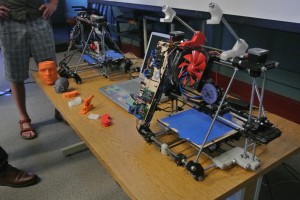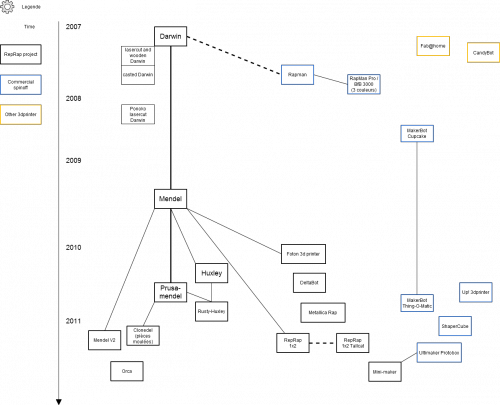
The price of 3D printers is plummeting. Like all complicated pieces of technology it is quickly moving from large, confusing, and expensive to small, simple and cheap. This year has been full of consumer-level 3D printers that are cheaper than some professional grade photo printers. Right now, these little things are capable of making plastic do-dads that are, admittedly, of lesser quality than some dollar store toys. But just like a magic trick, you’re not paying for the physical thing, you’re paying for the ability to do the trick. Design an object in a modeling software suite like SketchUp, convert it into some kind of printer-friendly format, and -so long as it is smaller than a bread box and made out of plastic- you can build whatever you want. 3D printers give an individual the ability to transform bits into atoms. In some ways it is a radical democratization of the means of production. For a fraction of the price of a car, someone can gain the ability to fabricate a relatively wide range of material objects. What are the implications for this new ability? What does it say about the relationship of atoms and bits?
Let’s get the sensationalist topics out of the way first: you can build weapons with 3D printers. As of this writing several high-traffic technology web sites are running stories about engineer Michael Guslick, who claims to have made “the first 3D printed gun.” Popular Science, ExtremeTech, DigitalTrends and LiveScience all have articles with misleading (or outright confusing) titles like “Functioning Rifle You Can Make at Home” and “Can 3D Printing Rock the Vice Market for Guns, Drugs, and Exotic Species?” The rhetoric in these articles would have any reader expecting to see home-made guns springing up all across the country. An interview with Guslick describes a far tamer story. He describes his creation as “extremely large and ungainly” and not a viable alternative to buying a traditional gun. From The New York Daily News:
“Criminals are not going to give this a second thought,” he said. “They will continue to look to the black market, rather than saying ‘Oh gee, we need to buy a 3D printer.’”
The gun enthusiast says he believes the media blew his story out of proportion.
“I guess this is a testament to how fearful people are of hearing that someone can 3D-print a gun without understanding that this wasn’t all that complex, it’s only in a legal sense that I have printed a firearm,” he said.

You can also get blue prints for knives, “brass” knuckles, and nun-chucks. Since there are very few regulations on any of these weapons, I don’t really see the introduction of 3D printers as a major change in humans’ ability and capacity to hurt each other using pre-existing technology. What is dangerous, and what none of these articles seems to notice, is that 3D printing gives millions of people the ability to prototype, test, and reproduce totally new kinds of deadly devices. And as Dr. Evan Selinger wrote last week in the Atlantic:
…the perceptual affordances offered by gun possession and the transformative consequences of yielding to these affordances. To someone with a gun, the world readily takes on a distinct shape. It not only offers people, animals, and things to interact with, but also potential targets. Furthermore, gun possession makes it easy to be bold, even hotheaded. Physically weak, emotionally passive, and psychologically introverted people will all be inclined to experience shifts in demeanor.
The danger isn’t in the ability to shoot people with home made guns, it is the kind of “transformative consequences” of 3D printer possession that lets us think of totally new ways of harming each other. Selinger (and indeed, most of the philosophy of technology) is concerned with the intent of and external influences on the technology’s designer and producer. Guns don’t make good hammers because the gun manufacturer is trying to make an excellent gun, not an excellent gun that is also good at one exceptional use (unless, of course, a sufficient market for hammering things right after you shoot them is found or developed). A 3D printer lets us customize our physical surroundings. One can imagine police departments, vigilantes, and militaries customizing guns for very specific “nonlethal” applications which have the underreported effect of actually increasing the use of force. People who really want lots of guns, don’t seem to be having a hard time getting them. We don’t need to worry about 3D printers making more guns, we need to worry about the new affordances they give those people that look to inflict violence.

The transformative consequences of 3D printers has a recursive element to it. In other words the sociotechnical relationship between designers, manufacturers, objects, supply chains, and end users start feeding back in new, much more immediate, ways. I can customize an object based on my specific needs. That capacity for customization leads to much more tailored tools and physical artefacts. This capacity is logically extended to the 3D printer itself, allowing the individual to fully (in theory) customize and specialize the construction process. Indeed, there is a thriving open source project for 3D printers made out of 3D printed parts called the RepRap Project. For about $400, a dedicated individual can build their own 3D printer and then use it to build most of the parts for future printers. The RepRap project has already produced over a hundred and fifty separate kinds of printers. As these machines gain in precision and function, they are capable of building better machines with even more precision and function.
Most of the discussions surrounding “atoms and bits” refer to social action and bodily co-presence. That is because our biggest technological advances have been in information exchange and not automated construction. Today’s 3D printers give us the opportunity to transmit physical objects as readily as we digitally transmitted images in the 70s. The first digital camera weighted 8 pounds and took 23 seconds to create a single black and white image. If (and I think its a big “if”) we were to develop the 3D printer as fast as we did the digital camera, we would be able to effortlessly transmit any physical object across time and space by the year 2050. I have no reason to believe that this is technically possible, or that human civilization will possess access to enough cheap fossil fuels to make tons and tons of plastic stuff. The point I want to make here however, has less to do with pragmatic feasibility, and more to do with how we treat the boundaries between the online and the offline.
My initial comparison of digital photography to 3D printing ignores the existence of the Internet and advances in digital data storage (the first digital camera relied on a casette tape). Consider the following thought experiment in which digital photography is stuck in 1970s but all other technologies are (more or less) up to 2012 standards. Given the possibility that both 70s-era quality digital photos and 2012 3D printing is possible, would we say that the black and white photo on the screen and the digital blueprint for a monochrome plastic toy horse are more or less real than a black and white film photo or a toy horse made in a conventional toy factory? Some would say yes. But if we transmit these bits across two computers and print out the black and white photo, and we extrude the plastic horse, these are incontestably “real” things. As the technology gets better (2012 digital photography, 2050 3D printing) the objects look better, but they do not become more “real.”

Baudrillard reminds us that we are surrounded by objects that refer to nonexistent entities. My Ikea furniture will never really give me the hip, urban mod lifestyle, the idea of which, was so necessary in the production of its value. Nuclear bombs are used as a deterrent, but only work as such as long as they effectively refer to a nonexistant world of nuclear winter. This is what Baudrillard called the simulacra. Objects that refer to nonexistent referents produce their own meaning through the very promise of the yet-to-be-realized future. But in a world where I can make my own object, where does reality come from? Are 3D printers extruding meaning and material agency along with ABS plastic? Are 3D printers ontological white holes that produce reality from their printer heads? This is the logical conclusion of digital dualism. That the online and offline are in a zero-sum competition with one-another. That they aren’t deeply connected or even inseparable. Modeling a bird house in software and then building it on a 3D printer is phenomenologically identical to sketching out a bird house on a piece of paper, and then build it with a saw, hammer, and nails. Just like the dangers of weapons production, the categorically different aspect of a 3D printer is my ability to produce a physical object that is identical to the virtual one (the only difference is one is made out of atoms, the other out of bits) and alter it to my own exacting specifications.
Our digitally augmented hyperreality precludes our ability to differentiate between reality and proxy, atoms and bits, or the real and the virtual. Indeed, the obsession over the differences between social action online and offline has blinded us to not only how alike they truly are, but how fungible the online and offline can be. I say “can be” because 3D printers represent a promise, not a reality. But it is that promise, when critically considered, that demands a symmetry across online and offline action. We cannot make a priori assumptions about what is more “real” or “meaningful” unless we are willing to rewrite entire theories of semiotics, value, and meaning.
You can follow David on Twitter, really! @da_banks

Comments 3
In Their Words » Cyborgology — August 5, 2012
[...] “Are 3D printers ontological white holes that produce reality from their printer heads?” [...]
Makers | NXT - branding in a world of social media, arts and rebellion — December 12, 2012
[...] under a creative commons license, and a series of musings, not at least over at the always engaging cyborology outlet of Nathan Jurgenson and his crew of digital theoreticians. Comments Are [...]
The Fungibility of Materiality | David A Banks — March 6, 2014
[…] Read more on Cyborgology […]